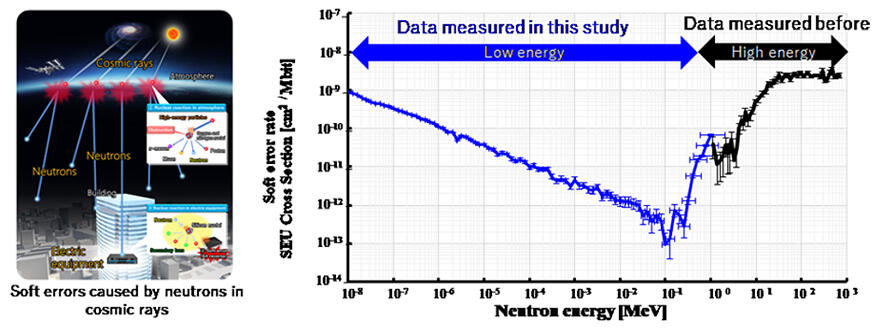Nippon Telegraph and Telephone Corporation (NTT) and Hokkaido University have jointly succeeded in measuring the semiconductor soft‐error rates at continuously varying neutron energies in the low‐energy range of 10 meV to 1 MeV, which have not previously been measured. This revealed the full picture for the first time in the world. NTT, in collaboration with Hokkaido University and Nagoya University, became the first in the world to measure the soft‐error rate in the high‐energy neutron region (1 to 800 MeV) in 2020, and this study followed that success. The study results were published in IEEE Transactions on Nuclear Science.

Provided by NTT
Countermeasures to soft errors, which are malfunctions caused by solar flares and radiation (cosmic rays) from the galaxy, are essential for the electronic equipment that supports our current social infrastructure. When cosmic rays, which pour down from space, collide with oxygen or nitrogen atoms in the atmosphere, neutrons are emitted. When these neutrons collide with the semiconductors in electronic equipment, they may cause 'soft errors,' a phenomenon whereby the data stored in a semiconductor are changed. This has the potential to impact social infrastructures in significantly adverse ways, such as through communication failures.
As a countermeasure for such damage, NTT has already established a soft‐error testing technology that can reproduce soft errors for the evaluation and study of countermeasures, and NTT Advanced Technology Corporation, a group company, started the 'Soft‐Error Testing Service' in 2016.
Today, soft‐error testing is conducted on electronic equipment in various fields, including the telecommunications field, contributing to the construction of a safe and secure social infrastructure. In addition, an ITU‐T Recommendation on countermeasures against and evaluation of soft errors, led by NTT, was defined in 2018.
In order to take countermeasures against soft errors in electronic equipment, it is important to design a system that takes into account the frequency of the soft‐error‐induced failures of each device. It is essential to concurrently obtain detailed data on the energy dependence of soft‐error rates (soft‐error rates at different neutron energies), because the frequency of soft‐error‐induced failures varies considerably depending on the energy of the neutrons that reach the device.
In this study, they measured soft errors caused by low‐energy neutrons of and below 1 MeV using the time‐of‐flight method with the high‐speed soft‐error detector announced in 2020. The time‐of‐flight method calculates the neutron speed and converts it to kinetic energy by measuring the time taken for the neutron to travel a certain distance.
The experiment was conducted by connecting a high‐speed soft‐error detector developed by NTT to the NeutrOn Beam Line for Observation and Research Use (NOBORU) installed at the Materials and Life Science Experimental Facility (MLF) of the Japan Proton Accelerator Research Complex (J‐PARC). The intensity of the neutrons used for irradiation at this facility was evaluated by Hokkaido University using the gold foil activation method.
In this experiment, the soft‐error rate in a field‐programmable gate array (FPGA), a type of integrated circuit, was measured while continuously varying the energy with high resolution. The obtained data showed that the soft‐error rate tended to be the lowest around 0.1 MeV and increased with decreasing energy. They assumed that this was due to the influence of boron 10, which is present in trace amounts in semiconductors.
Among the low‐energy neutrons, the soft‐error rate was higher with neutrons in the energy band around 25 meV (2.5 × 10−8 MeV), which are known as thermal neutrons. These thermal neutrons are produced when high‐energy neutrons lose speed after entering hydrogen‐containing materials, such as water, plastics and electronic substrates, and their number considerably varies depending on the surrounding environment.
For example, if semiconductors are cooled by water, the number of thermal neutrons is expected to increase significantly. Therefore, the data obtained in this study will make it possible to simulate the number of failures due to soft errors considering the surrounding environment of electronic equipment and to take countermeasures for this energy region.
NTT will continue its efforts to build a safer and more secure social infrastructure by simulating the number of failures due to soft errors while taking into account the surrounding environment of electronic equipment and developing soft‐error countermeasures for low‐energy regions.
In the future, NTT also plans to apply the results of its research to devise countermeasures against cosmic rays in space, thereby helping to realize NTT's goal of an integrated space computing network, as well as assisting humanity's advance into space.
This article has been translated by JST with permission from The Science News Ltd. (https://sci-news.co.jp/). Unauthorized reproduction of the article and photographs is prohibited.




